Bosch Power Tools 26618-01, 26618BL, 26618B User Manual

 BM 2609140646 07-09:BM 2609140646 07-09 7/29/09 2:17 PM Page 1
BM 2609140646 07-09:BM 2609140646 07-09 7/29/09 2:17 PM Page 1
IMPORTANT: |
IMPORTANT : |
IMPORTANTE: |
Read Before Using |
Lire avant usage |
Leer antes de usar |
|
|
|
Operating/Safety Instructions 
 Consignes de fonctionnement/sécurité
Consignes de fonctionnement/sécurité
Instrucciones de funcionamiento y seguridad
26614
26618
|
Call Toll Free for |
Pour obtenir des informations |
Llame gratis para |
|
|
Consumer Information |
et les adresses de nos centres |
obtener información |
|
||
|
& Service Locations |
de service après-vente, |
para el consumidor y |
|
|
|
|
appelez ce numéro gratuit |
ubicaciones de servicio |
|
|
|
|
|
|
||
|
1-877-BOSCH99 (1-877-267-2499) www.boschtools.com |
|
|
||
|
|
|
|
|
|
For English Version |
Version française |
Versión en español |
|
||
|
See page 2 |
Voir page 19 |
Ver la página 36 |
|
|
|
|
|
|
|
|

 BM 2609140646 07-09:BM 2609140646 07-09 7/29/09 2:17 PM Page 2
BM 2609140646 07-09:BM 2609140646 07-09 7/29/09 2:17 PM Page 2
General Power Tool Safety Warnings
! WARNING Read all safety warnings and instructions. Failure to follow the warnings and instructions may result in electric shock, fire and/or serious injury.
SAVE ALL WARNINGS AND INSTRUCTIONS FOR FUTURE REFERENCE
The term “power tool” in all of the warnings refers to your mains-operated (corded) power tool or battery-operated (cordless) power tool.
Work area safety
Keep work area clean and well lit. Cluttered or dark areas invite accidents.
Do not operate power tools in explosive atmospheres, such as in the presence of flammable liquids, gases or dust. Power tools create sparks which may ignite the dust or fumes.
Keep children and bystanders away while operating a power tool. Distractions can cause you to lose control.
Electrical safety
Power tool plugs must match the outlet. Never modify the plug in any way. Do not use any adapter plugs with earthed (grounded) power tools. Unmodified plugs and matching outlets will reduce risk of electric shock.
Avoid body contact with earthed or grounded surfaces such as pipes, radiators, ranges and refrigerators. There is an increased risk of electric shock if your body is earthed or grounded.
Do not expose power tools to rain or wet conditions. Water entering a power tool will increase the risk of electric shock.
Do not abuse the cord. Never use the cord for carrying, pulling or unplugging the power tool. Keep cord away from heat, oil, sharp edges or moving parts. Damaged or entangled cords increase the risk of electric shock.
When operating a power tool outdoors, use an extension cord suitable for outdoor use. Use of a cord suitable for outdoor use reduces the risk of electric shock.
If operating the power tool in damp locations is unavoidable use a Ground Fault Circuit Interrupter (GFCI) protected supply. Use of an GFCI reduce the risk of electric shock.
Personal safety
Stay alert, watch what you are doing and use common sense when operating a
power tool. Do not use a power tool while you are tired or under the influence of drugs, alcohol or medication. A moment of inattention while operating power tools may result in serious personal injury.
Use personal protective equipment. Always wear eye protection. Protective equipment such as dust mask, non-skid safety shoes, hard hat, or hearing protection used for appropriate conditions will reduce personal injuries.
Prevent unintentional starting. Ensure the switch is in the off-position before connecting to power source and / or battery pack, picking up or carrying the tool.
Carrying power tools with your finger on the switch or energizing power tools that have the switch on invites accidents.
Remove any adjusting key or wrench before turning the power tool on. A wrench or a key left attached to a rotating part of the power tool may result in personal injury.
Do not overreach. Keep proper footing and balance at all times. This enables better control of the power tool in unexpected situations.
Dress properly. Do not wear loose clothing or jewelry. Keep your hair, clothing and gloves away from moving parts. Loose clothes, jewelry or long hair can be caught in moving parts.
If devices are provided for the connection of dust extraction and collection facilities, ensure these are connected and properly used. Use of dust collection can reduce dustrelated hazards.
Power tool use and care
Do not force the power tool. Use the correct power tool for your application. The correct power tool will do the job better and safer at the rate for which it was designed.
Do not use the power tool if the switch does not turn it on and off. Any power tool that cannot be controlled with the switch is dangerous and must be repaired.
-2-

 BM 2609140646 07-09:BM 2609140646 07-09 7/29/09
BM 2609140646 07-09:BM 2609140646 07-09 7/29/09
Disconnect the plug from the power source and/or the battery pack from the power tool before making any adjustments, changing accessories, or storing power tools. Such preventive safety measures reduce the risk of starting the power tool accidentally.
Store idle power tools out of the reach of children and do not allow persons unfamiliar with the power tool or these instructions to operate the power tool. Power tools are dangerous in the hands of untrained users.
Maintain power tools. Check for misalignment or binding of moving parts, breakage of parts and any other condition that may affect the power tools operation. If damaged, have the power tool repaired before use.
Many accidents are caused by poorly maintained power tools.
Keep cutting tools sharp and clean. Properly maintained cutting tools with sharp cutting edges are less likely to bind and are easier to control.
Use the power tool, accessories and tool bits etc. in accordance with these instructions, taking into account the working conditions and the work to be performed. Use of the power tool for operations different from those intended could result in a hazardous situation.
2:17 PM Page 3
Battery tool use and care
Recharge only with the charger specified by the manufacturer. A charger that is suitable for one type of battery pack may create a risk of fire when used with another battery pack.
Use power tools only with specifically designated battery packs. Use of any other battery packs may create a risk of injury and fire.
When battery pack is not in use, keep it away from other metal objects like paper clips, coins, keys, nails, screws, or other small metal objects that can make a connection from one terminal to another.
Shorting the battery terminals together may cause burns or a fire.
Under abusive conditions, liquid may be ejected from the battery, avoid contact. If contact accidentally occurs, flush with water. If liquid contacts eyes, additionally seek medical help. Liquid ejected from the battery may cause irritation or burns.
Service
Have your power tool serviced by a qualified repair person using only identical replacement parts. This will ensure that the safety of the power tool is maintained.
Safety Rules for Cordless Impact Drivers
Hold tools by insulated gripping surfaces when performing an operation where the cutting tool may contact hidden wiring.
Contact with a "live" wire will make exposed metal parts of the tool "live" and shock the operator.
Use clamps or other practical way to secure and support the workpiece to a stable platform. Holding the work by hand or against your body is unstable and may lead to loss of control.
Do not drill, fasten or break into existing walls or other blind areas where electrical wiring may exist. If this situation is unavoidable, disconnect all fuses or circuit breakers feeding this worksite.
Always wear safety goggles or eye protection when using this tool.
Wear ear protectors when using the tool for extended periods. Prolonged exposure to high intensity noise can cause hearing loss.
Use thick cushioned gloves and limit the exposure time by taking frequent rest periods. Vibration caused by hammer-drill action may be harmful to your hands and arms.
Secure the material being fastened. Never hold it in your hand or across your legs.
Unstable support can cause loss of control and injury.
Avoid accidental starting. Be sure the forward/reverse switch is in the off position before inserting battery pack.
Carrying appliances with your finger on the switch or inserting the battery pack into an appliance with the switch on invites accidents.
-3-

 BM 2609140646 07-09:BM 2609140646 07-09 7/29/09 2:17 PM Page 4
BM 2609140646 07-09:BM 2609140646 07-09 7/29/09 2:17 PM Page 4
Remove battery pack before changing accessories. Accidental starting may occur because battery appliances with a battery inserted are in the operative condition.
Be prepared for a reaction torque when “seating” or removing a fastener. The screwdriver housing may tend to twist in the opposite direction of bit rotation when “seating” or removing a fastener depending on the torque setting of the tool.
Do not use dull or damaged bits and accessories. When installing an accessory, insert the shank of the bit well within the chuck. Be sure the chuck has locked onto the bit correctly.
Do not run the tool while carrying it at your side. A spinning bit could become entangled with clothing and injury may result.
Place the tool onto the fastener only when the screwdriver is switched off. Rotating driver tools can slide off the fastener.
Do not use this tool as a drill. Tools equipped with shut-off clutches are not designed for drilling applications. The clutch can shut off automatically and without warning.
Be careful when driving long screws – there is a risk of sliding off the fastener head depending on type of socket or bit used. First test the run-down of a fastener and pay attention during the screw driving process to ensure you do not injure yourself if the tool bit or socket slides off of the fastener.
Some dust created by power sanding, sawing, grinding, drilling and other construction
activities contains chemicals known to cause cancer, birth defects or other reproductive harm. Some examples of these chemicals are:
•Lead from lead-based paints
•Crystalline silica from bricks, cement and other masonry products.
•Arsenic and chromium from chemically treated lumber.
Your risk from these exposures varies depending on how often you do this type of work. To reduce your exposure to these chemicals, work in a well-ventilated area and work with approved safety equipment such as dust masks designed to filter out microscopic particles.
Safety Rules for Drills
Wear ear protectors with impact drills.
Exposure to noise can cause hearing loss.
Use auxiliary handles supplied with the tool. Loss of control can cause personal injury.
Hold tool by insulated gripping surfaces when performing an operation where the cutting tools may contact hidden wiring or its own cord. Contact with a “live” wire will make exposed metal parts of the tool “live” and shock the operator.
Use clamps or other practical way to secure and support the workpiece to a stable platform. Holding the work by hand or against your body is unstable and may lead to loss of control.
Do not drill, fasten or break into existing walls or other blind areas where electrical wiring may exist. If this situation is unavoidable, disconnect all fuses or circuit
breakers feeding this worksite.
Always wear safety goggles or eye protection when using this tool. Use a dust mask or respirator for applications which generate dust.
Secure the material being drilled. Never hold it in your hand or across legs.
Unstable support can cause the drill bit to bind causing loss of control and injury.
Never leave the trigger locked "ON". Before plugging the tool in, check that the trigger lock is "OFF". Accidental start-ups could cause injury.
Position the cord clear of rotating bit. Do not wrap the cord around your arm or wrist. If you lose control and have the cord wrapped around your arm or wrist it may entrap you and cause injury.
Position yourself to avoid being caught between the tool or side handle and walls
-4-
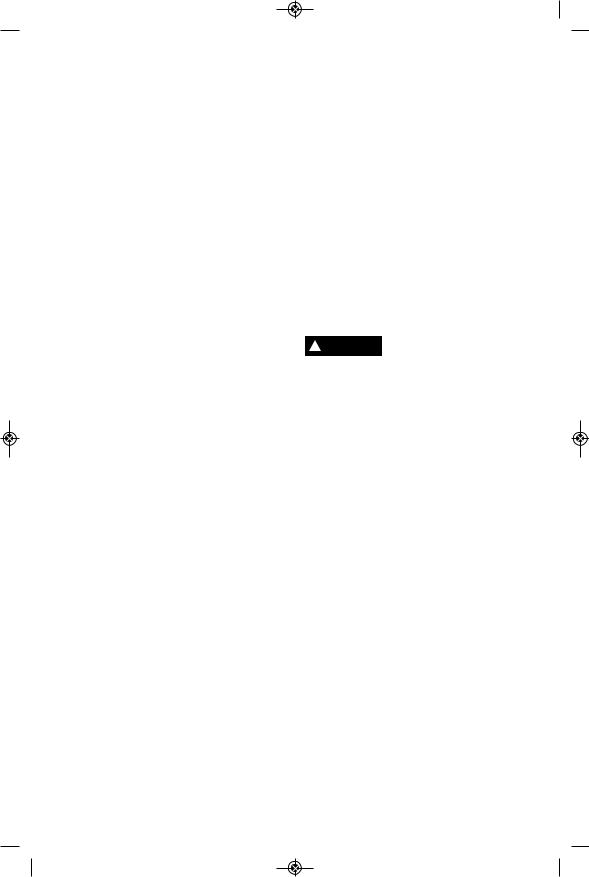
 BM 2609140646 07-09:BM 2609140646 07-09 7/29/09 2:17 PM Page 5
BM 2609140646 07-09:BM 2609140646 07-09 7/29/09 2:17 PM Page 5
or posts. Should the bit become bound or jammed in the work, the reaction torque of the tool could crush your hand or leg.
If the bit becomes bound in the workpiece, release the trigger immediately, reverse the direction of rotation and slowly squeeze the trigger to back out the bit. Be ready for a strong reaction torque. The drill body will tend to twist in the opposite direction as the drill bit is rotating.
Do not grasp the tool or place your hands too close to the spinning chuck or drill bit. Your hand may be lacerated.
Do not use the switch "Lock-ON" feature in situations where drill bit binding is likely. (For example: just before the bit is ready to break through the material, anytime when using a "Hole Saw", auger bits........ etc.) When the bit binds, the drill's body will twist or kick-back in opposite direction and the release of the trigger "LockON" may be difficult.
Be aware of the location and setting of the switch "Lock-ON" button. If the switch is locked "ON" during the use, be ready for emergency situations to switch it "OFF", by first pulling the trigger then immediately releasing it without pressing the "Lock-ON" button.
When installing a drill bit, insert the shank of the bit well within the jaws of the chuck. If the bit is not inserted deep enough, the grip of the jaws over the bit is reduced and the loss of control is increased.
Do not use dull or damaged bits and accessories. Dull or damaged bits have a greater tendency to bind in the workpiece.
When removing the bit from the tool avoid contact with skin and use proper protective gloves when grasping the bit or accessory. Accessories may be hot after prolonged use.
Check to see that keys and adjusting wrenches are removed from the drill before switching the tool "ON". Keys or wrenches can fly away at high velocity striking you or a bystander.
Do not run the drill while carrying it at your side. A spinning drill bit could become entangled with clothing and injury may result.
This tool may be used with sanding and polishing disks, grinding wheels, wire wheel and wire cup brushes. These accessories must be rated for at least the speed recommended on the tool warning label. Wheels and other accessories running over rated speed can fly apart and cause injury.
Avoid bouncing and snagging the wheels, discs or brushes especially when working corners, sharp edges, etc. This can cause loss of control and kickback.
Some dust created by power sanding, sawing, grinding, drilling, and other construction
activities contains chemicals known to cause cancer, birth defects or other reproductive harm. Some examples of these chemicals are:
•Lead from lead-based paints,
•Crystalline silica from bricks and cement and other masonry products, and
•Arsenic and chromium from chemicallytreated lumber.
Your risk from these exposures varies, depending on how often you do this type of work. To reduce your exposure to these chemicals: work in a well ventilated area, and work with approved safety equipment, such as those dust masks that are specially designed to filter out microscopic particles.
-5-
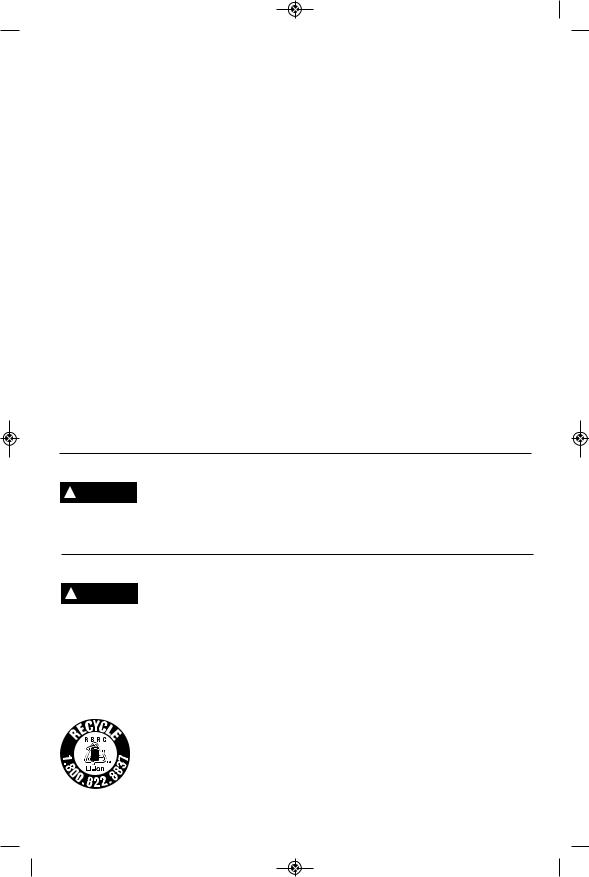
 BM 2609140646 07-09:BM 2609140646 07-09 7/29/09 2:17 PM Page 6
BM 2609140646 07-09:BM 2609140646 07-09 7/29/09 2:17 PM Page 6
Battery/Charger
Before using battery charger, read all instructions and cautionary markings on
(1) battery charger, (2) battery pack, and (3) product using battery.
Use only the charger which accompanied your product or direct replacement as listed in the catalog or this manual. Do not substitute any other charger. Use only Bosch approved chargers with your product. See Functional Description and Specifications.
Do not disassemble charger or operate the charger if it has received a sharp blow, been dropped or otherwise damaged in any way. Replace damaged cord or plugs immediately. Incorrect reassembly or damage may result in electric shock or fire.
Do not recharge battery in damp or wet environment. Do not expose charger to rain or snow. If battery case is cracked or otherwise damaged, do not insert into charger. Battery short or fire may result.
Charge only Bosch approved rechargeable batteries. See Functional Description and Specifications. Other types of batteries may burst causing personal injury and damage.
Charge battery pack in temperatures above +32 degrees F (0 degrees C) and below
+113 degrees F (45 degrees C). Store tool and battery pack in locations where temperatures will not exceed 120 degrees F (49 degrees C). This is important to prevent serious damage to the battery cells.
Battery leakage may occur under extreme usage or temperature conditions. Avoid contact with skin and eyes. The battery liquid is caustic and could cause chemical burns to tissues. If liquid comes in contact with skin, wash quickly with soap and water. If the liquid contacts your eyes, flush them with water for a minimum of 10 minutes and seek medical attention.
Place charger on flat non-flammable surfaces and away from flammable materials when re-charging battery pack.
The charger and battery pack heat during charging. Carpeting and other heat insulating surfaces block proper air circulation which may cause overheating of the charger and battery pack. If smoke or melting of the case are observed unplug the charger immediately and do not use the battery pack or charger.
Use of an attachment not recommended or sold by Bosch will result in a risk of fire, electric shock or injury to persons.
Battery Care
! WARNING When batteries are not in tool or charger, keep them
away from metal objects. For example, to protect terminals from shorting DO NOT place batteries in a tool box or pocket with
nails, screws, keys, etc. Fire or injury may result.
DO NOT PUT BATTERIES INTO FIRE OR ExPOSE TO HIGH HEAT. They may explode.
Battery Disposal
! WARNING Do not attempt to disassemble the battery or
remove any component projecting from the battery terminals. Fire or injury may result. Prior to disposal, protect exposed terminals with heavy insulating tape to prevent shorting.
LITHIUM-ION BATTERIES
If equipped with a lithium-ion battery, the battery must be collected, recycled or disposed of in an environmentally sound manner.
“The EPA certified RBRC Battery Recycling Seal on the lithium-ion (Li-ion) battery indicates Robert Bosch Tool Corporation is voluntarily participating in an industry
program to collect and recycle these batteries at the end of their useful life, when taken out of service in the United States or Canada. The RBRC program provides a convenient alterative to placing used Li-ion batteries into the trash or the municipal waste stream, which may be illegal in your area.
Please call 1-800-8-BATTERY for information on Li-ion battery recycling and disposal bans/restrictions in your area, or return your batteries to a Skil/Bosch/Dremel Service Center for recycling. Robert Bosch Tool Corporation’s involvement in this program is part of our commitment to preserving our environment and conserving our natural resources.”
-6-
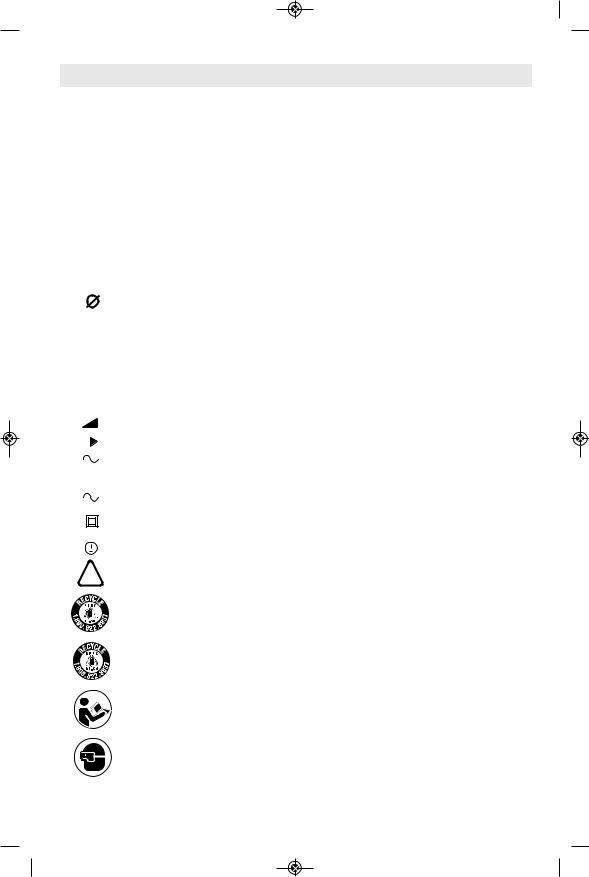
 BM 2609140646 07-09:BM 2609140646 07-09 7/29/09 2:18 PM Page 7
BM 2609140646 07-09:BM 2609140646 07-09 7/29/09 2:18 PM Page 7
Symbols
IMPORTANT: Some of the following symbols may be used on your tool. Please study them and learn their meaning. Proper interpretation of these symbols will allow you to operate the tool better and safer.
Symbol |
Name |
Designation/Explanation |
|||||||
|
|
|
|
|
|
|
|
|
|
|
|
V |
Volts |
Voltage (potential) |
|||||
|
|
|
|
|
|
|
|
|
|
|
|
A |
Amperes |
Current |
|||||
|
|
|
|
|
|
|
|
|
|
|
Hz |
Hertz |
Frequency (cycles per second) |
||||||
|
|
|
|
|
|
|
|
|
|
|
W |
Watt |
Power |
||||||
|
|
|
|
|
|
|
|
|
|
|
kg |
Kilograms |
Weight |
||||||
|
|
|
|
|
|
|
|
|
|
min |
Minutes |
Time |
|||||||
|
|
|
|
|
|
|
|
|
|
|
|
|
s |
Seconds |
Time |
||||
|
|
|
|
|
|
|
|
|
|
|
|
|
|
|
|
|
|
Diameter |
Size of drill bits, grinding wheels, etc. |
|
|
|
|
|
|
|
|
|
|
|
n0 |
No load speed |
Rotational speed, at no load |
||||||
.../min |
Revolutions or reciprocation |
Revolutions, strokes, surface speed, |
|||||||
|
|
|
|
|
|
|
|
per minute |
orbits etc. per minute |
|
|
|
|
|
|
|
|
|
|
0 |
|
|
|
Off position |
Zero speed, zero torque... |
||||
|
|
|
|
|
|
|
|
|
|
1, 2, 3, ... |
Selector settings |
Speed, torque or position settings. |
|||||||
I, II, III, |
|
Higher number means greater speed |
|||||||
|
|
|
|
|
|
|
|
|
|
0 |
|
|
|
|
|
|
Infinitely variable selector with off |
Speed is increasing from 0 setting |
|
|
|
|
|
|
|
|
|
|
|
|
|
|
|
|
|
|
|
Arrow |
Action in the direction of arrow |
|
|
|
|
|
|
|
|
||
|
|
|
|
|
|
|
|
|
|
|
|
|
|
|
|
|
|
Alternating current |
Type or a characteristic of current |
|
|
|
|
|
|
|
|
|
|
|
|
|
|
|
|
|
|
Direct current |
Type or a characteristic of current |
|
|
|
|
|
|
|
|
||
|
|
|
|
|
|
|
|
|
|
|
|
|
|
|
|
|
|
Alternating or direct current |
Type or a characteristic of current |
|
|
|
|
|
|
|
|
||
|
|
|
|
|
|
|
|
|
|
|
|
|
|
|
|
|
|
Class II construction |
Designates Double Insulated |
|
|
|
|
|
|
|
|
||
|
|
|
|
|
|
|
|
|
Construction tools. |
|
|
|
|
|
|
|
|
|
|
|
|
|
|
|
|
|
|
|
|
|
|
|
|
|
|
|
|
Earthing terminal |
Grounding terminal |
|
|
|
|
|
|
|
|
||
|
|
|
|
|
|
|
|
|
|
|
|
|
|
|
|
|
|
Warning symbol |
Alerts user to warning messages |
|
|
|
|
|
|
|
|
|
|
|
|
|
|
|
|
|
|
|
|
|
|
|
|
|
|
|
|
Li-ion RBRC seal |
Designates Li-ion battery recycling |
|
|
|
|
|
|
|
|
|
program |
|
|
|
|
|
|
|
|
|
|
|
|
|
|
|
|
|
|
Ni-Cad RBRC seal |
Designates Ni-Cad battery recycling |
|
|
|
|
|
|
|
|
|
program |
|
|
|
|
|
|
|
|
|
|
|
|
|
|
|
|
|
|
Read manual symbol |
Alerts user to read manual |
|
|
|
|
|
|
|
|
|
|
|
|
|
|
|
|
|
|
Wear eye protection symbol |
Alerts user to wear eye protection |
|
|
|
|
|
|
|
|
|
|
-7-
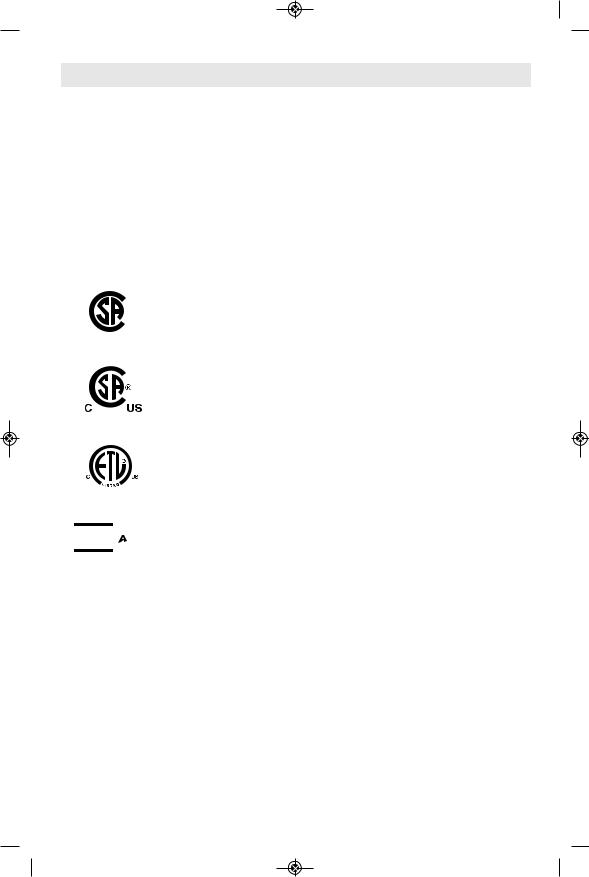
 BM 2609140646 07-09:BM 2609140646 07-09 7/29/09 2:18 PM Page 8
BM 2609140646 07-09:BM 2609140646 07-09 7/29/09 2:18 PM Page 8
Symbols (continued)
IMPORTANT: Some of the following symbols may be used on your tool. Please study them and learn their meaning. Proper interpretation of these symbols will allow you to operate the tool better and safer.
This symbol designates that this tool is listed by Underwriters Laboratories.
This symbol designates that this tool is listed by Underwriters Laboratories, to United States and Canadian Standards.
This symbol designates that this tool is listed by the Canadian Standards
Association.
This symbol designates that this tool is listed by the Canadian Standards
Association, to United States and Canadian Standards.
This symbol designates that this tool is listed by the Intertek Testing
Services, to United States and Canadian Standards.



 This symbol designates thatthis tool compliesto NOM Mexican Standards.
This symbol designates thatthis tool compliesto NOM Mexican Standards.
-8-
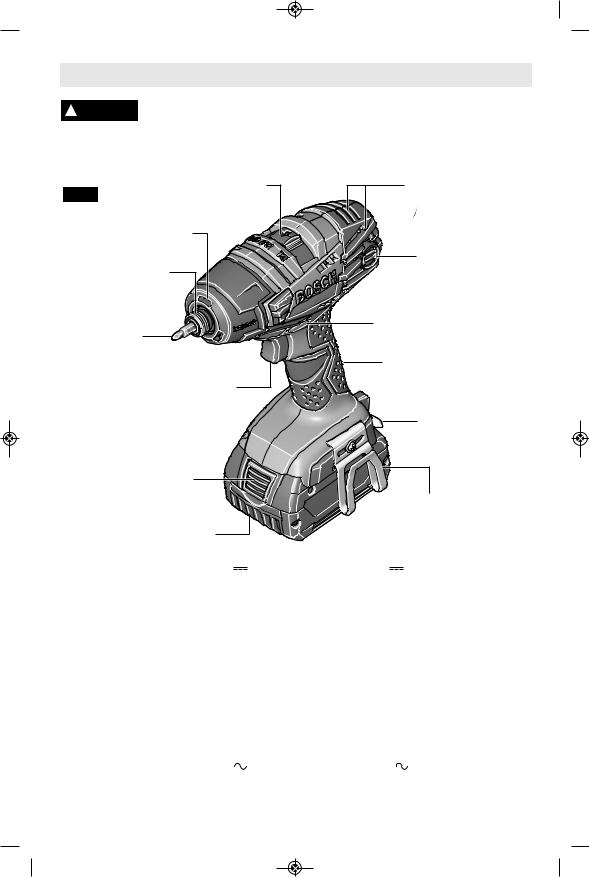
 BM 2609140646 07-09:BM 2609140646 07-09 7/29/09 2:18 PM Page 9
BM 2609140646 07-09:BM 2609140646 07-09 7/29/09 2:18 PM Page 9
Functional Description and Specifications
Disconnect battery pack from tool before making any assembly, adjustments or changing accessories. Such preventive safety measures
reduce the risk of starting the tool accidentally.
Cordless Impact Driver / 2 Speed Drill
MODE SELECTOR |
|
VENTILATION |
||
FIG. 1 |
SWITCH |
|
|
OPENINGS |
BUILT IN WORK LIGHT |
|
|
|
|
|
|
|
|
BRUSH COVER |
LOCKING SLEEVE |
|
|
|
|
|
|
|
FORWARD/REVERSING |
|
BIT |
|
|
LEVER & TRIGGER LOCK |
|
|
|
|
|
|
|
|
|
RUBBERIZED GRIP |
|
VARIABLE SPEED |
|
|
|
|
TRIGGER SWITCH |
|
|
|
|
|
|
|
|
BIT AND BIT |
|
|
|
|
STORAGE AREA |
BATTERY PACK |
|
|
|
|
RELEASE BUTTON |
|
|
|
|
|
|
|
|
BELT CLIP |
BATTERY PACK |
|
|
|
|
Model number |
26614 |
|
26618 |
|
Voltage rating |
14.4V |
|
18 V |
|
Drill Mode |
|
|
|
|
No load speed 1 |
n0 0-750/min |
n0 0-750/min |
||
No load speed 2 |
n0 0-2,800/min |
n0 0-2,800/min |
||
Fasten Mode |
|
|
|
|
No load speed |
n0 0-2,800/min |
n0 0-2,800/min |
||
Impact Rate |
0-3200 |
|
0-3200 |
|
Max torque |
1,400 in-lbs |
1,500 in-lbs |
||
Maximum Capacities |
|
|
|
|
Chuck size |
1/4" Hex-shank with power groove |
1/4" Hex-shank with power groove |
||
Battery pack |
BAT607 & BAT614 |
BAT609 & BAT618 |
||
|
BAT607G & BAT614G |
BAT609G & BAT618G |
||
Charger |
BC630 & BC660 |
BC630 & BC660 |
||
Voltage rating |
120 V |
60 Hz |
120 V |
60 Hz |
NOTE: For tool specifications refer to the nameplate on your tool.
-9-
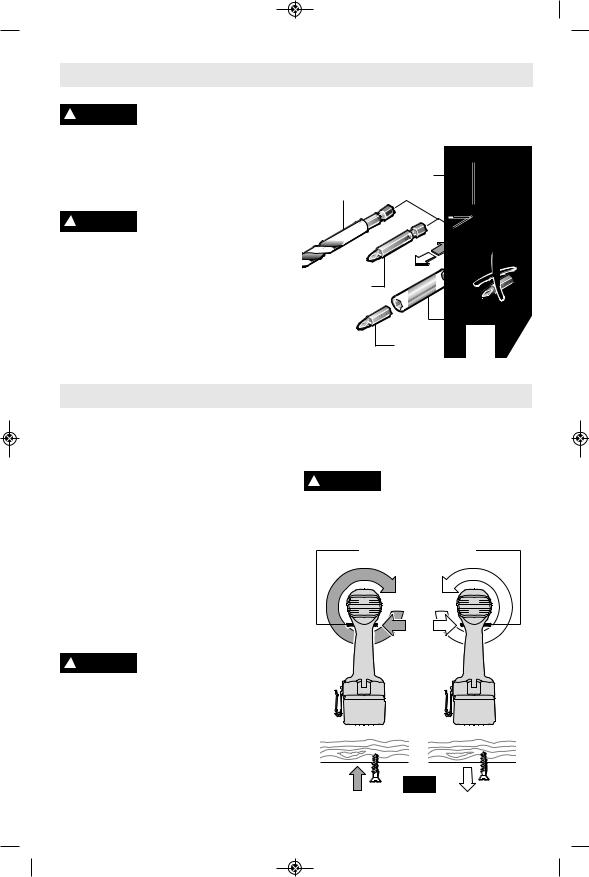
 BM 2609140646 07-09:BM 2609140646 07-09 7/29/09 2:18 PM Page 10
BM 2609140646 07-09:BM 2609140646 07-09 7/29/09 2:18 PM Page 10
Assembly
Disconnect battery pack ! WARNING from tool before making
any assembly, adjustments or changing accessories. Such preventive safety measures reduce the risk of starting the tool accidentally.
INSERTING AND REMOVING
ACCESSORIES
To avoid loss of control, ensure bit is locked in chuck
by pulling on bit after it has been inserted.
The chuck accepts only standard 1/4" hexagonal shank accessories with power groove.
Your tool is equipped with a quick release chuck. To insert an accessory, simply pull locking sleeve forward, insert desired accessory into chuck and release locking sleeve (Fig. 2).
To remove an accessory, pull locking sleeve forward and simply remove it from the chuck.
FIG. 2 |
LOCKING SLEEVE |
CHUCK
HEX-SHANK
DRILL BIT
SCREWDRIVER |
BIT |
BIT HOLDER |
SCREWDRIVER BIT |
Operating Instructions
VARIABLE SPEED CONTROLLED |
For reverse rotation move the lever to the far |
||
TRIGGER SWITCH |
right. To activate trigger lock move lever to the |
||
Your tool is equipped with a variable speed |
center off position. |
||
trigger switch. The tool can be turned "ON" or |
! WARNING |
Do not change direction of |
|
"OFF" by squeezing or releasing the trigger. |
|||
The speed can be adjusted from the minimum |
|
rotation until the tool |
|
comes to a complete stop. Shifting during |
|||
to maximum nameplate RPM by the pressure |
|||
rotation of the chuck can cause damage to the |
|||
you apply to the trigger. Apply more pressure |
|||
tool. |
|
||
to increase the speed and release pressure to |
|
||
FORWARD/REVERSING |
|||
decrease speed (Fig. 1). |
|||
BRAKE |
LEVER & TRIGGER LOCK |
||
|
|
||
When the trigger switch is released it activates |
|
|
|
the brake to stop the chuck quickly. This is |
|
|
|
especially useful in the repetitive driving and |
|
|
|
removal of screws. |
|
|
|
FORWARD/REVERSING
LEVER & TRIGGER LOCK
After tool use, lock trigger in “OFF” position to help prevent
accidental starts and accidental discharge.
Your tool is equipped with a forward/ reversing lever and trigger lock located above the trigger (Fig. 3). This lever was designed for changing rotation of the bit, and for locking the trigger in an “OFF” position.
For forward rotation, (with chuck pointed away |
|
from you) move the lever to the far left. |
FIG. 3 |
-10-

 BM 2609140646 07-09:BM 2609140646 07-09 7/29/09 2:18 PM Page 11
BM 2609140646 07-09:BM 2609140646 07-09 7/29/09 2:18 PM Page 11
MODE SELECTOR SWITCH |
! |
CAUTION |
To prevent damage to tool |
|
The selector switch allows the tool to be set |
always check to make sure |
|||
|
|
|||
for various Drilling/Impact Driving applications. |
the mode selector switch is fully engaged |
|||
The mode selector switch has three settings. |
into desired setting. If you have difficulty |
|||
Speed 1 drill only: provides |
fully engaging the switch, lightly squeeze and |
|||
release the trigger before pushing the switch |
||||
slower speeds for drilling with large |
||||
into desired setting. |
||||
diameter bits in wood, metal, |
||||
FIG. 4 |
|
|||
ceramics and plastic. |
|
|||
Speed 2 drill only: provides faster speeds for drilling with small diameter bits in wood, metal,
ceramics and plastic.
Driving with impact action:
Provides high torque and high speed to drive screws, bolts, nuts
and other common fasteners.
Do not operate the selection ! CAUTION switch until the tool comes
to a complete stop. Shifting during rotation of the chuck can cause damage to the tool.
To change speeds slide switch to desired setting (Fig. 4).
BUILT IN WORK LIGHT |
The belt clip can be attached to either side of |
||
Your tool is also equipped with a light that turns |
the tool by securing it with a mounting screw. |
||
on automatically when the switch is activated, |
Always make sure you securely tighten the |
||
for better visibility when driving (Fig. 1). |
mounting screw before use (Fig. 5). |
||
BIT STORAGE AREA |
To use clip, turn tool upside down and attach |
||
Your tool is equipped with a bit and storage |
to your belt. |
||
area that is conveniently located in the handle |
FIG. 5 |
||
base where it is always handy and unlikely to |
|||
|
|||
get lost or misplaced (Fig. 5). |
BIT AND BIT |
||
|
BELT CLIP |
||
|
STORAGE |
||
! WARNING |
When the tool is attached to |
AREA |
|
the belt, position yourself to |
|
||
avoid entanglement with surrounding objects. |
|
||
Unexpected entanglement could cause the tool |
|
||
to fall resulting in injury to the operator or |
|
||
bystanders. |
|
|
|
The optional belt clip accessory will allow you to |
|
||
conveniently attach your tool to your belt. This |
|
||
feature will allow you to have both hands free |
|
||
when climbing a ladder or moving to another |
BELT CLIP |
||
work area. |
|
|
|
-11-
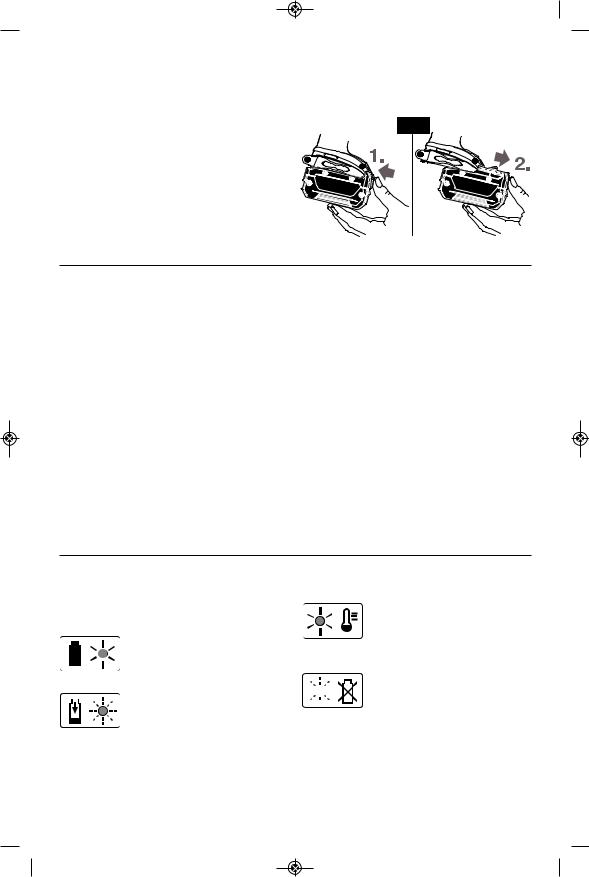
 BM 2609140646 07-09:BM 2609140646 07-09 7/29/09 2:18 PM Page 12
BM 2609140646 07-09:BM 2609140646 07-09 7/29/09 2:18 PM Page 12
INSERTING AND RELEASING BATTERy PACK
Set Forward/Reversing lever to the center (off position). Slide charged battery pack into the housing until the battery pack locks into position (Fig. 6).
Your tool is equipped with a secondary locking latch to prevent the battery pack from completely falling out of the handle, should it become loose due to vibration.
To remove the battery pack, press the battery pack release button and slide the battery pack forward.
Press the battery pack release button again and slide the battery pack completely out of tool housing (Fig. 6).
FIG. 6
IMPORTANT CHARGING NOTES
1.The charger was designed to fast charge the battery only when the battery temperature is between 32˚F (0˚C) and 113˚F (45˚C). If the battery pack is too hot or too cold, the charger will not fast charge the battery. (This may happen if the battery pack is hot from heavy use). When the battery temperature returns to between 32˚F (0˚C) and 113˚F (45˚C), the charger will automatically begin charging.
2.A substantial drop in operating time per charge may mean that the battery pack is nearing the end of its life and should be replaced.
3.Remember to unplug charger during storage period.
4.If battery does not charge properly:
a.Check for voltage at outlet by plugging in some other electrical device.
b.Check to see if outlet is connected to a light switch which turns power “off” when lights are turned off.
c.Check battery pack terminals for dirt. Clean with cotton swab and alcohol if necessary.
d.If you still do not get proper charging, take or send tool, battery pack and charger to your local Bosch Service Center. See “Tools, Electric” in the Yellow Pages for names and addresses.
Note: Use of chargers or battery packs not sold by Bosch will void the warranty.
CHARGER INDICATORS, SyMBOLS AND MEANING (Model BC630)
If the indicator lights are “OFF”, the charger is not receiving power from power supply outlet.
If the green indicator light is “ON”,
the charger is plugged in but the battery pack is not inserted, or
the battery pack is fully charged.
If the green indicator light is “BLINKING”, the battery pack is being fast-charged. Fast-charging
will automatically stop when the battery pack is fully charged.
If the red indicator light is “ON”, the battery pack is too hot or cold for fast-charging. The charger will
automatically switch to fast-charging once a suitable temperature is reached.
If the red indicator light is




 “BLINKING”, the battery pack
“BLINKING”, the battery pack  cannot accept a charge or the contacts of the charger or battery pack are
cannot accept a charge or the contacts of the charger or battery pack are
contaminated. Clean the contacts of the charger or battery pack only as directed in these operating instructions or those supplied with your tool or battery pack.
-12-
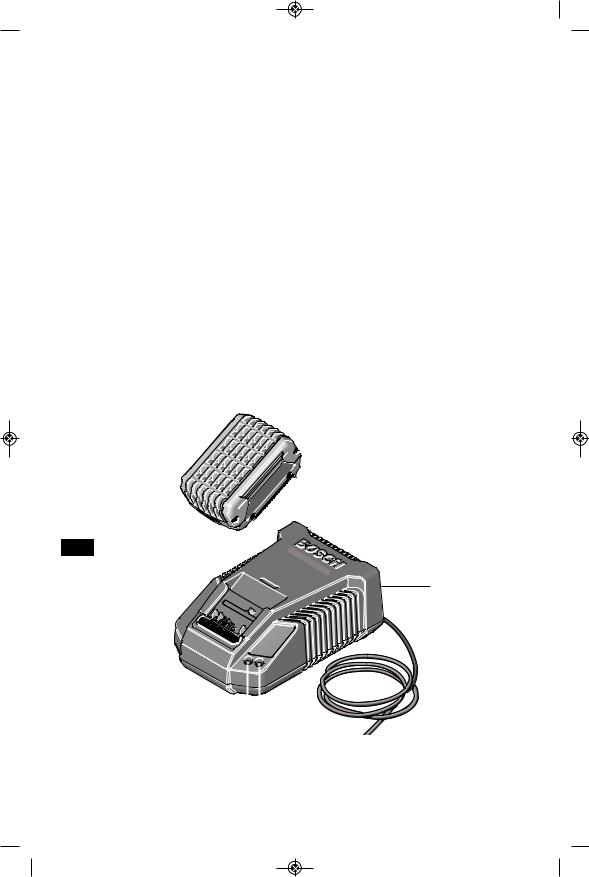
 BM 2609140646 07-09:BM 2609140646 07-09 7/29/09 2:19 PM Page 13
BM 2609140646 07-09:BM 2609140646 07-09 7/29/09 2:19 PM Page 13
CHARGING BATTERy PACK (Model BC630)
Plug charger cord into your standard power outlet.
With no battery pack inserted, the charger’s green indicator light will go ON. This indicates the charger is receiving power and the charger is ready for operation.
When you insert the battery pack into the charger. The charger’s green indicator light will begin to “BLINK”. This indicates that the battery is receiving a fast charge (Fig. 7).
When the indicator light stops “BLINKING” (and becomes a steady green light) fast charging is complete. The battery pack is fully charged and can be removed from the charger.
The battery pack may be used even though the light may still be blinking. The light may require more time to stop blinking depending on temperature.
The purpose of the green light is to indicate that the battery pack is fast-charging. It does not indicate the exact point of full charge. The light will stop blinking in less time if the battery pack was not completely discharged.
When you begin the charging process of the battery pack, a steady red light could also mean the battery pack is too hot or too cold.
Fast charging is only possible when the temperature range of the battery pack is between 32˚F (0˚C) and 113˚F (45˚C). When needed, the internal fan of the charger will turn on to aid the charging process and speed.
As soon as the battery pack reaches the correct temperature range, the battery charger will automatically switch to fast charging.
If the red indicator light is “BLINKING”, the battery pack cannot accept a charge.
•Check to make sure the battery pack is inserted into the charger properly.
•Clean the contacts of the charger or battery pack (e. g. by inserting and removing the battery several times) or replace the battery pack, as required.
When the battery pack is fully charged, unplug the charger (unless you're charging another battery pack) and slip the battery pack back into the tool.





 BATTERY
BATTERY
PACK
FIG. 7
CHARGER
RED LIGHT |
|
|
|
GREEN LIGHT |
|
|
|
-13-
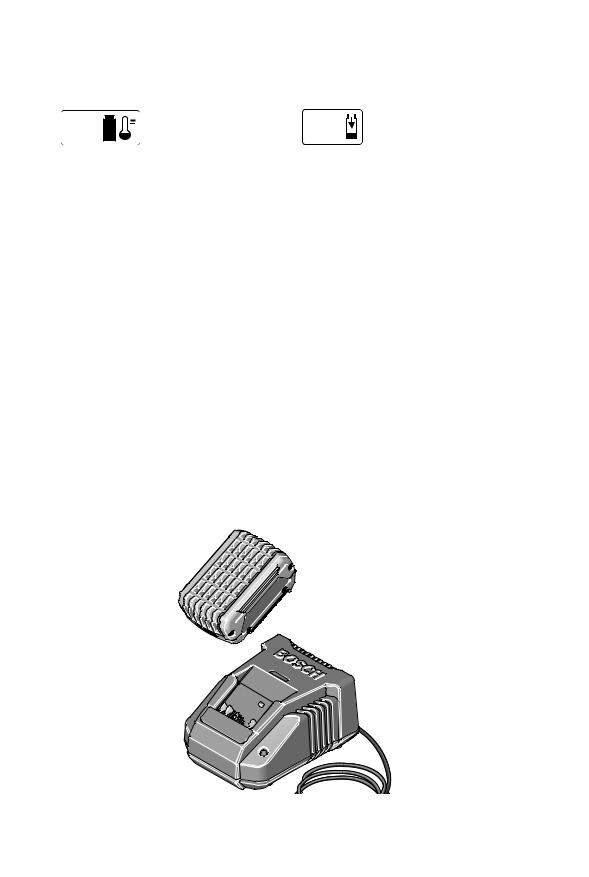
 BM 2609140646 07-09:BM 2609140646 07-09 7/29/09 2:19 PM Page 14
BM 2609140646 07-09:BM 2609140646 07-09 7/29/09 2:19 PM Page 14
CHARGER INDICATORS, SyMBOLS AND MEANING (Model BC660)
If the indicator lights are “OFF”, the charger is not receiving power from power supply outlet.
If the green indicator light is

 “ON”, the charger is plugged in but the battery pack is not inserted, or the battery pack is fully charged, or
“ON”, the charger is plugged in but the battery pack is not inserted, or the battery pack is fully charged, or
the battery pack is too hot or cold for fastcharging. The charger will automatically switch
to fast-charging once a suitable temperature is reached.
If the green indicator light is 
 “BLINKING”, the battery pack is being fast-charged. Fastcharging will automatically stop when the
“BLINKING”, the battery pack is being fast-charged. Fastcharging will automatically stop when the
battery pack is fully charged.
CHARGING BATTERy PACK (Model BC660)
Plug charger cord into your standard power |
As soon as the battery pack reaches the |
|||
outlet. |
correct temperature range, the battery charger |
|||
With no battery pack inserted, the charger’s |
will automatically switch to fast charging. |
|||
|
|
|||
green indicator light will go ON. This indicates |
The battery pack may be used even though the |
|||
the charger is receiving power and the charger |
light may still be blinking. The light may require |
|||
is ready for operation. |
more time to stop blinking depending on |
|||
When you insert the battery pack into the |
temperature. |
|||
|
|
|||
charger, the charger’s green indicator light will |
The purpose of the green light is to indicate that |
|||
begin to “BLINK”. This indicates that the battery |
the battery pack is fast-charging. It does not |
|||
is receiving a fast charge (Fig. 8). |
indicate the exact point of full charge. The light |
|||
When the indicator light stops “BLINKING” (and |
will stop blinking in less time if the battery pack |
|||
was not completely discharged. |
||||
becomes a steady green light) fast charging is |
||||
|
|
|||
complete. The battery pack is fully charged and |
If the green indicator light is “ON”, the battery |
|||
can be removed from the charger. |
pack cannot accept a charge. |
|||
When you begin the charging process of the |
• Check to make sure the battery pack is |
|||
battery pack, a steady green light could also |
inserted into the charger properly. |
|||
mean the battery pack is too hot or too cold. |
• Clean the contacts of the charger or battery |
|||
|
|
|||
Fast charging is only possible when the |
pack (e. g. by inserting and removing the |
|||
battery several times) or replace the battery |
||||
pack, as required. |
||||
temperature range of the battery pack is |
|
|
||
between 32˚F (0˚C) and 113˚F (45˚C). When |
|
|
||
needed, the internal fan of the charger will turn |
When the battery pack is fully charged, unplug |
|||
on to aid the charging process and speed. |
||||
the charger (unless you're charging another |
||||
|
|
|||
|
|
battery pack) and slip the battery pack back into |
||
|
|
the tool. |
||
|
|
BATTERY |
||
|
|
|
PACK |
|
|
|
|
||
|
|
|
|
|
|
|
|
|
|
CHARGER
-14-
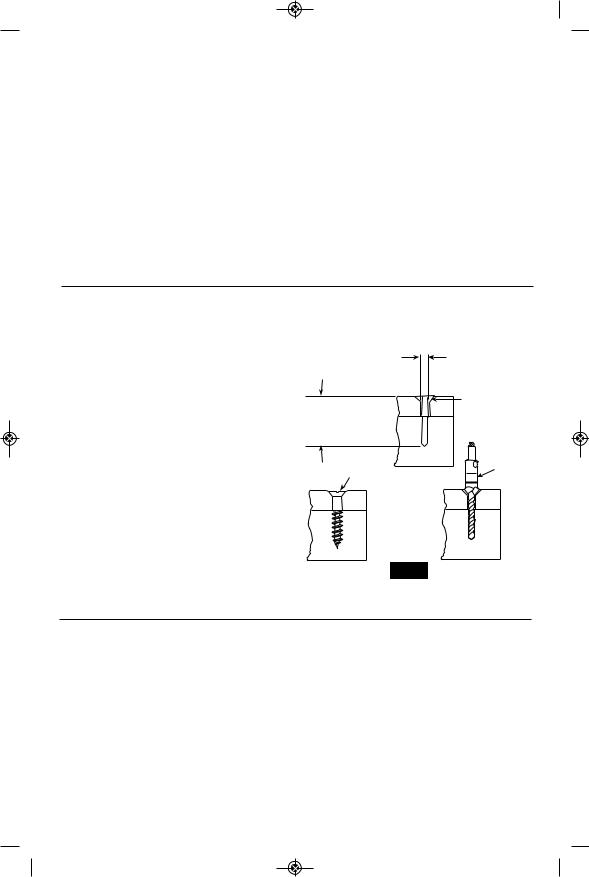
 BM 2609140646 07-09:BM 2609140646 07-09 7/29/09 2:19 PM Page 15
BM 2609140646 07-09:BM 2609140646 07-09 7/29/09 2:19 PM Page 15
Operating Tips
You will extend the life of your bits and do neater work if you always put the bit in contact with the work before pulling the trigger. During the operation, hold the tool firmly and exert light, steady pressure. Too much pressure at low speed will stall the tool. Too little pressure will keep the bit from cutting and cause excess friction by sliding over the surface. This can be damaging to both tool and bit.
DRILLING WITH VARIABLE SPEED
The trigger controlled variable speed feature will eliminate the need for center punches in
hard materials. The variable speed trigger allows you to slowly increase RPM. By using a slow starting speed, you are able to keep the bit from “wandering”. You can increase the speed as the bit “bites” into the work by squeezing the trigger.
DRIVING WITH VARIABLE SPEED
Variable speed drills will double as a power screwdriver by using a screwdriver bit in the drill mode. The technique is to start slowly, increasing the speed as the screw runs down. Set the screw snugly by slowing to a stop. Prior to driving screws, pilot and clearance holes should be drilled.
FASTENING WITH SCREWS
This procedure shown in (Fig. 9) will enable you to fasten materials together with your Cordless Drill/Screwdriver without stripping, splitting or separating the material.
First, clamp the pieces together and drill the first hole 2/3 the diameter of the screw. If the material is soft, drill only 2/3 the proper length. If it is hard, drill the entire length.
Second, unclamp the pieces and drill the second hole the same diameter as the screw shank in the first or top piece of wood.
Third, if flat head screw is used, countersink the hole to make the screw flush with the surface. Then, simply apply even pressure when driving the screw. The screw shank clearance hole in the first piece allows the screw head to pull the pieces tightly together.
The adjustable screw drill accessory will do all of these operations quickly and easily.
Screw drills are available for screw sizes No. 6, 8, 10 and 12.
FASTENING
WITH SCREWS
1. Drill 2/3 diameter and 2/3 of screw length for soft materials, full length for hard materials.
Screw
Apply a slight even pressure when driving screws.
2. Drill same diameter as screw shank.
3. Countersink same diameter as screw head.
Adjustable
Screw
Drill
FIG. 9
DRILL BITS
Always inspect drill bits for excessive wear. Use only bits that are sharp and in good condition.
TWIST BITS: Available with straight and reduced shanks for wood and light duty metal drilling. High speed bits cut faster and last longer on hard materials.
DRILLING WOOD
Be certain workpiece is clamped or anchored firmly. Always apply pressure in a straight line with the drill bit. Maintain enough pressure to keep the drill “biting”.
-15-

 BM 2609140646 07-09:BM 2609140646 07-09 7/29/09
BM 2609140646 07-09:BM 2609140646 07-09 7/29/09
When drilling holes in wood, twist bits can be used. Twist bits may overheat unless pulled out frequently to clear chips from flutes.
Use a “back-up” block of wood for work that is likely to splinter, such as thin materials.
You will drill a cleaner hole if you ease up on the pressure just before the bit breaks through the wood. Then complete the hole from the back side.
2:19 PM Page 16
DRILLING METAL
There are two rules for drilling hard materials. First, the harder the material, the greater the pressure you need to apply to the tool. Second, the harder the material, the slower the speed. Here are a couple of tips for drilling in metal. Lubricate the tip of the bit occasionally with cutting oil except when drilling soft metals such as aluminum, copper or cast iron. If the hole to be drilled is fairly large, drill a smaller hole first, then enlarge to the required size, it’s often faster in the long run. Maintain enough pressure to assure that the bit does not just spin in the hole. This will dull the bit and greatly shorten its life.
Before using an accessory, ! WARNING be certain that its maximum
safe operating speed is not exceeded by the nameplate speed of the tool. Do not exceed the recommended wheel diameter.
SANDING AND POLISHING
Fine sanding and polishing require “touch”. Select the most efficient speed.
When using polishing bonnets, always be sure the excess string that secures the bonnet is tucked well within the bonnet during operation.
WIRE BRUSHES
Work with brushes requires high speeds.
BRUSHING PRESSURE
1.Remember, the tips of a wire brush do the work. Operate the brush with the lightest pressure so only the tips of the wire come in contact with the work.
2.If heavier pressures are used, the wires will be overstressed, resulting in a wiping action; and if this is continued, the life of the brush will be shortened due to wire fatigue.
3.Apply the brush to the work in such a way that as much of the brush face as possible is in full contact with the work. Applying the side
or edge of the brush to the work will result in wire breakage and shortened brush life.
RUNNING NUTS AND BOLTS
Variable speed control must be used with caution for driving nuts and bolts with socket set attachments. The technique is to start slowly, increasing speed as the nut or bolt runs down. Set the nut or bolt snugly by slowing the drill to a stop. If this procedure is not followed, the tool will have a tendency to torque or twist in your hands when the nut or bolt seats.
CORRECT: Wire tips doing the work.
INCORRECT: Excessive pressure can cause wire breakage.
-16-
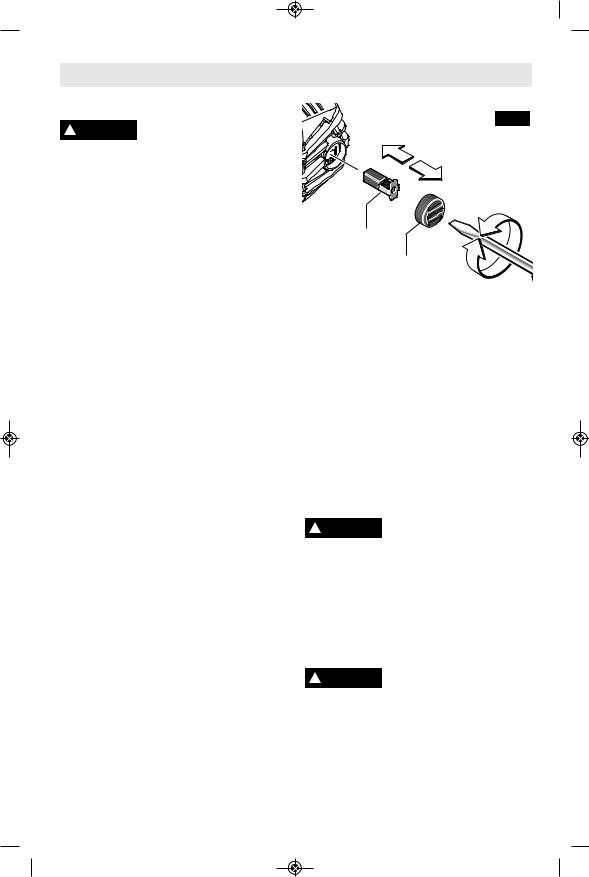
 BM 2609140646 07-09:BM 2609140646 07-09 7/29/09 2:19 PM Page 17
BM 2609140646 07-09:BM 2609140646 07-09 7/29/09 2:19 PM Page 17
Maintenance
Service
NO USER SERVICEABLE
PARTS INSIDE. Preventive maintenance performed by unauthorized personnel may result in misplacing of internal wires and components which could cause serious hazard. We recommend that all tool service be performed by a Bosch Factory Service Center or Authorized Bosch Service Station. SERVICEMEN: Disconnect tool and/or charger from power source before servicing.
BATTERIES
Be alert for battery packs that are nearing their end of life. If you notice decreased tool performance or significantly shorter running time between charges then it is time to replace the battery pack. Failure to do so can cause the tool to operate improperly or damage the charger.
TOOL LUBRICATION
Your Bosch tool has been properly lubricated and is ready for use.
CARBON BRUSHES
The brushes and commutator in your tool have been engineered for many hours of dependable service.
If your tool runs sporadically, loses power, makes unusual noises or runs at a reduced speed, check the brushes. To continue using the tool in this condition will permanently damage your tool.
Check both brushes. Usually the brushes will not wear out simultaneously. If one brush is worn out, replace both brushes.
To check brushes: Disconnect battery pack from tool. Rotate brush cap at the rear part of housing counter-clockwise with a coin or screwdriver and remove cap (Fig. 10).
Lift out the brushes; note which way they face, so that the brushes can be returned to their original position. New brushes can also be inserted turned 180º. Clean the brush holder openings with compressed air or a clean cloth and replace the brushes and brush covers.
After replacing brushes the tool should be run at no-load and run it freely at full speed for 2
FIG. 10
BRUSH
BRUSH
CAP
minutes before using the tool. This will allow the brushes to “seat” properly and will give you more hours of life from each set of brushes.
Only genuine Bosch replacement brushes specially designed for your tool should be used.
D.C. MOTORS
The motor in your tool has been engineered for many hours of dependable service. To maintain peak efficiency of the motor, we recommend it be examined every six months. Only a genuine Bosch replacement motor specially designed for your tool should be used.
Cleaning
To avoid accidents, always disconnect the tool and/or charger from the power supply before
cleaning. The tool may be cleaned most effectively with compressed dry air. Always wear safety goggles when cleaning tools with compressed air.
Ventilation openings and switch levers must be kept clean and free of foreign matter. Do not attempt to clean by inserting pointed objects through opening.
Certain cleaning agents and solvents damage plastic parts. Some of these are: gasoline,
carbon tetrachloride, chlorinated cleaning solvents, ammonia and household detergents that contain ammonia.
-17-
